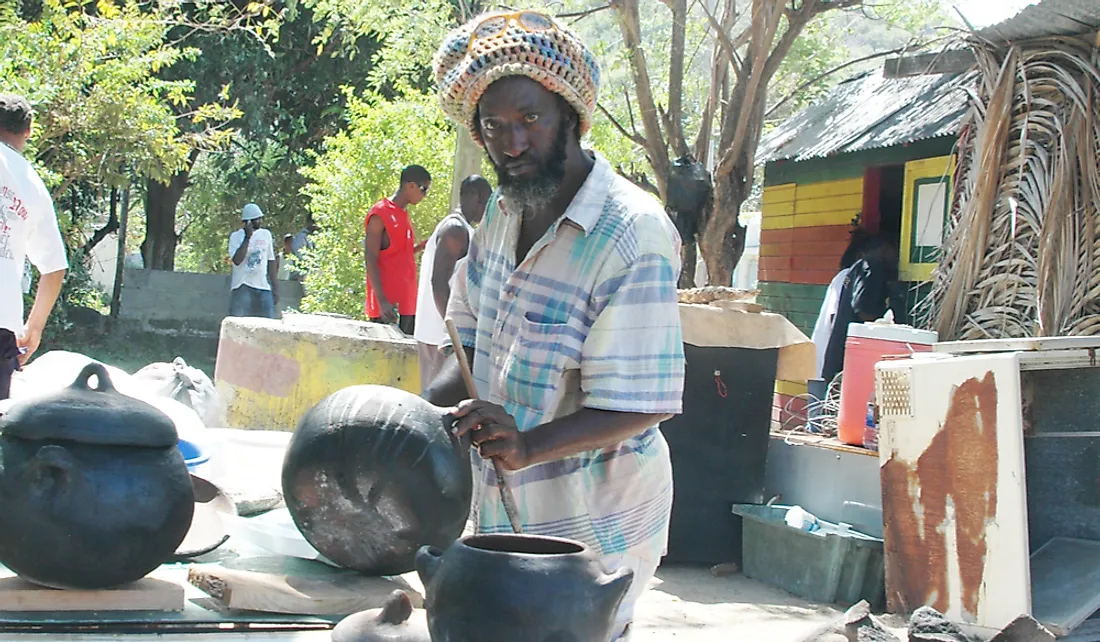The Culture Of St. Vincent And The Grenadines

St. Vincent and the Grenadines is an island nation located in the Caribbean Sea in the Lesser Antilles island arc. The culture of the nation reflects the influences of the cultures of its various immigrant populations.
Ethnicity, Language, and Religion in St. Vincent and the Grenadines
The country hosts a population of around 101,844 individuals. People of African descent comprise the majority (72.8%) of the country’s population. Those of mixed descent account for 20% of the total population. Individuals of East Indian origin, European origin, and island Caribs make up 1.4%, 4%, and 3.6% of the country’s population, respectively. English, Vincentian Creole English, and French patois are the most spoken languages in St. Vincent and the Grenadines. Christianity is the religion of the vast majority. Protestant Christianity is followed by 70.6% of the population.
The Cuisine of the Country
The fertile volcanic soils of the country allow the growth of a variety of crops. The presence of the sea means that seafood is found in plenty. Thus, most of the food is sourced locally. Breadfruit is a staple of the diet and is found throughout the nation. Fried jack fish and roasted breadfruit together comprise the national dish of the nation. An annual Breadfruit Festival is also held which features multiple types of breadfruit preparations, music, and dancing. Arrowroot is also grown on the islands. The flour derived from arrowroot is used to prepare biscuits, cakes, jellies, bread, sauces, and other food items. The madongo dumpling is a baked or fried snack made with arrowroot flour, coconut, and nutmeg.
A wide variety of seafood is like octopus, lobster, squid, fishes, etc., are also eaten by the Islanders in the baked, fried, stewed, or grilled form. The billjau is a popular local dish. It is a stew of salted fish, coconut oil, onions, tomatoes, and hot peppers. Fruits and vegetables like potatoes, tomatoes, eggplant, ginger, cabbages, yams, carrots, plantains, bananas, etc., are also locally produced and consumed.
Literature, Art, and Craft
Most of the Vincentian literature is in the oral form. Folktales and legends, myths, poetry, etc., are passed down through generations in the informal way. The people of the country also love to create jokes, riddles, and stories and present them in an entertaining way in informal gatherings.
A variety of art and craft is produced in the country. The natural beauty of the island nation inspires painters to produce mesmerizing landscape paintings. Eggshell mosaics, coconut helicopters, goatskin drums, hand-crafted jewelry, wood carvings, and carnival dolls are some of the popular handicrafts produced by the country’s craftsmen. Baskets, hats, mats, and toys are made using the fibres, wood, and other raw materials that are locally available.
Music and Dance in St. Vincent and the Grenadines
The country has a thriving music scene that ranges from traditional storytelling to reggae, calypso, soca, and Big Drum. Other popular styles of music in the country are quadrille, steelpan, and bélé music. Although Big drum music has a presence throughout the Windward Islands, Big Drum from St. Vincent and the Grenadines is particularly famous. The drums are made from either tree trunks or rum kegs. The music is performed on special occasions like weddings. Songs and dances often accompany Big Drum music. The Saint Vincent island also hosts an annual carnival called the Vincy Mas. A variety of music, songs, and dances are performed during this festival.
Sports Played in the Country
Association football, rugby, and cricket are the most popular sports played in the country. Other games like netball, volleyball, tennis, track, and field, and basketball are also played. The NLA Premier League of the country is the primary source of players for the country’s national football team. The national basketball team of the St. Vincent And The Grenadines participates in international competitions like the Caribbean Basketball Championship. The national rugby union team is ranked 84th in the world.
Social Life in the Country
The society of the island country is exhibits slight patriarchal bias with men enjoying a somewhat higher status than women. Both women and men, however, participate in economic activities both in the rural and urban areas. Traditionally, rural men engage in fishing and other seafaring activities, and the labor-intensive agricultural work. Women engage in some of the less labor-intensive agricultural work, household chores, and childcare. Women also sell local produce at markets while men sell fish. Overall, women are generally paid less than men.
Three forms of conjugal unions are recognized in St. Vincent And The Grenadines, legal marriage, cohabitation without legal marriage, and visiting relationship (where couples stay apart but visit each other). Legal marriages usually take place quite late in the life of a couple, often after they have had several children together. A significant number of both women and men tend to have multiple partners in the course of their life.
Households size in the country is highly flexible. Extended, nuclear, and single-member households are all common. Children are adored by Vincentians. The entire family participates in child upbringing. Usually, children are not named until they are about a month old. It is a common custom to bury the navel-string of a newborn under a fruit-bearing tree to ensure a healthy and happy life of the child. Education is free but not compulsory in the country. With little skilled employment opportunities on the island country, many Vincentians are over-educated on the whole. Vincentians are known for their generous behavior. They can go to a great extent to help those in need.











